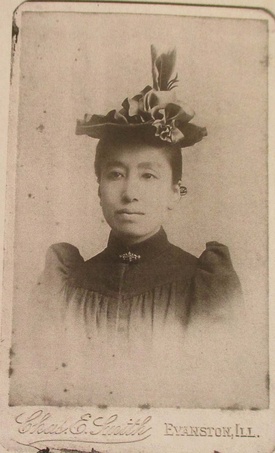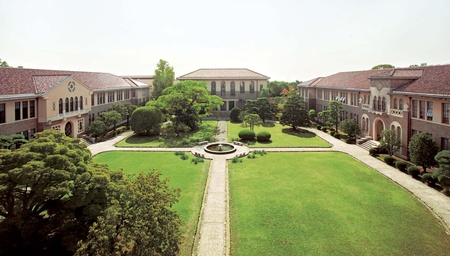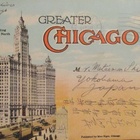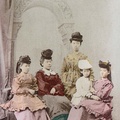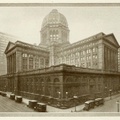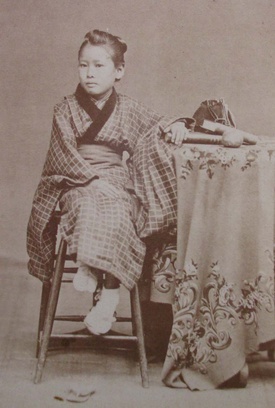
Hishikawa Yasu came to Chicago in 1886, guided by Presbyterian Sarah Cummings. After graduating from the English Speaking School for Japanese Young Ladies (later known as Yokohama Kyoritsu Gakuen), which had been opened in Yokohama in 1871 by the Women's United Overseas Mission Board, Yasu received her medical training while helping Sarah in Kanazawa. In Chicago, she entered Chicago Woman's Medical College, Sarah's alma mater, and graduated in 1889. Specializing in gynecology and pediatrics, Yasu did not return to Japan immediately after graduation, but instead lived and trained at the Foundlings Home for orphans in Chicago. In 1890, Yasu became the first Japanese woman to obtain a medical license in Illinois.
After graduating from Kobe Eiwa Girls' School in 1889, Mori Shizuko traveled to the United States in July 1891 at the age of 18. After spending two months in California, she entered Northwestern University in the fall of 1891 and studied modern literature at the College of Liberal Arts. At the Columbian Exposition held in Chicago in 1893, she worked in the secretariat as an interpreter and translator for the examiners who had come from Japan.
Fuji Koga, one of the 12 students who graduated from Kobe Eiwa Girls' School in 1882, first came to Chicago in September 1890. She had traveled to the United States in 1887 to study early childhood education at a nursery school in the eastern United States, and had stopped off in Chicago on her way back to Japan. After returning to Japan, Fuji's first job was at Annie Howe's Shoei Kindergarten. In 1905, when she returned to the United States, she enrolled in the School of Education at the University of Chicago.
At the end of August 1890, Fuji Tsukamoto was in Chicago to meet Fuji Koga who was returning from Boston. Fuji graduated from Kobe Eiwa Girls' School in 1886 and taught at her alma mater, but she was going to study abroad at Wilson College in Pennsylvania and had stopped by Annie's sister's house in Ridgeland, Illinois.
Thanks to the musical education of Mary Ellen Wainwright at Doshisha Girl's School, Tonami Hayashi came to Illinois to study music. She graduated from Doshisha Girl's School in 1888, and obtained a permit to study English and music in 1892. Tonami first studied for two years in the preparatory class at Tabor College in Iowa, Wainwright's alma mater, before transferring to Rockford Girl's School, where she enrolled in the music department and studied for two years.
Strongly influenced by Denton at Doshisha Girls' School, Hisa Nagano and Natsu Ito came to Chicago shortly after graduating in 1892. The two studied nursing at the Clara Barton Training School for Nurses and the National Temperance Hospital, both affiliated with the Women's Christian Temperance Union, and dreamed of establishing a hospital in Japan that would practice a new, alcohol-free treatment method.
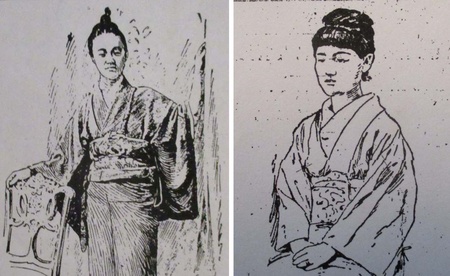
In addition to Hisa Nagano and Natsu Ito, there were several other Japanese women who came to Chicago under the influence of the Women's Christian Temperance Union. Shige Kushida was one of them. She went to America in 1889 and was supposed to study on a scholarship from the Women's Christian Temperance Union, but things did not go well and she soon moved to California.
After attending the Women's Christian Temperance Union convention at the Columbian Exposition, Sakurai Chikako, vice president of the Tokyo Women's Temperance Union, enrolled in Moody Bible Institute in Chicago in November 1893, becoming the first Japanese female student there. During her nearly two-year stay in America, she appealed for support for the Mary Allen West Memorial Fund, which had been established in Japan before she came to America.
Mary Allen West was a missionary sent to Japan in September 1892 by the Women's Christian Temperance Union. She was from Galesburg, Illinois, the same place as missionary Thomas Winn, who established the Presbyterian Kanazawa Station. She was scheduled to give lectures calling for abstinence and smoking cessation from Hokkaido to Kyushu, but she died in Kanazawa while visiting Mrs. Winn, a former student of hers from her Galesburg days. Before her death, West organized the Women's Temperance Union in Yokkaichi, Mie Prefecture. Komai Tomie, who served as its secretary-general, joined Moody Bible Institute in September 1894 after Sakurai had left.
In addition to these women, there must have been many other Japanese Christian women who set foot in Chicago. Even if they are unknown and there are no records of them, there is no doubt about their strong will and passionate passion.
The ambition for a new era that motivated Christian women in Japan and the United States lives on in Chicago to this day.
After World War I, Kobe College aimed to transform into a full-fledged women's university, and was supported by the Kobe College Corporation (KCC), which was organized in 1920 by Chicago businessmen, educators, and members of the Women's Mission Bureau. To build a new building for Kobe College, fundraising committees were formed not only in Chicago but in 30 other cities in the United States, mobilizing people who were passionate about the development of higher education for women in Japan. Over the next decade, KCC raised a total of $700,000.
In 1921, Kobe College and Rockford College established a sister school relationship. I wonder if this relationship became known in the Japanese American community. In 1921, the vice president of the World Goodwill Club, which was established at Rockford College, was a Japanese American woman named Marion Akagi. In June 1923, Jane Addams visited Kobe College and encouraged the young Japanese women.
Speaking of Japanese Americans and Kobe College, it is also worth noting that Japanese-born Charlotte B. Deforest, who served as president of Kobe College from 1917 to 1940, served as a volunteer counselor* at the Manzanar internment camp and worked to improve the lives of Japanese and Japanese Americans.
Even today in the 21st century, the search for and energy for Japan-U.S. cooperation by women for women that was born in Chicago, including KCC, which continues to operate through scholarships and exchange programs, is timeless and immortal.
*Note: The link to this photo is from the KCC website Support page .
© 2023 Takako Day


